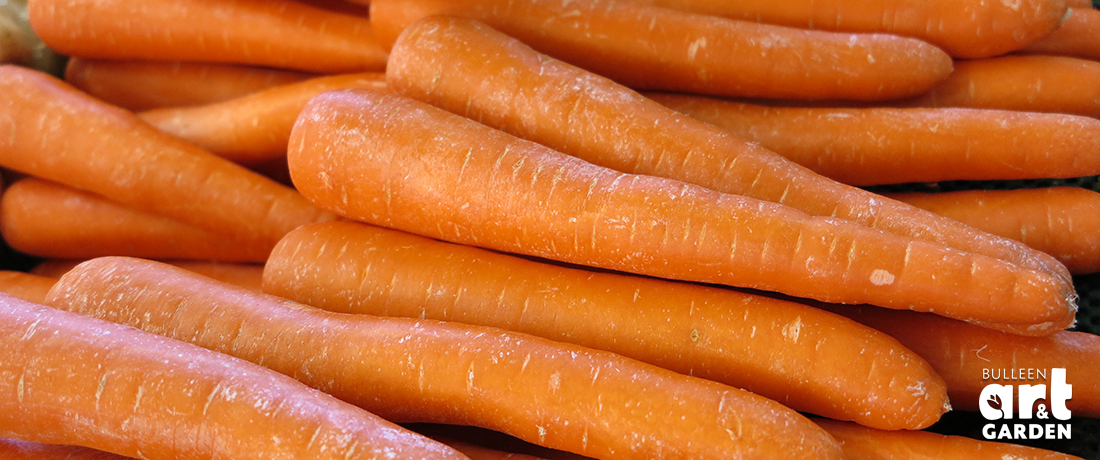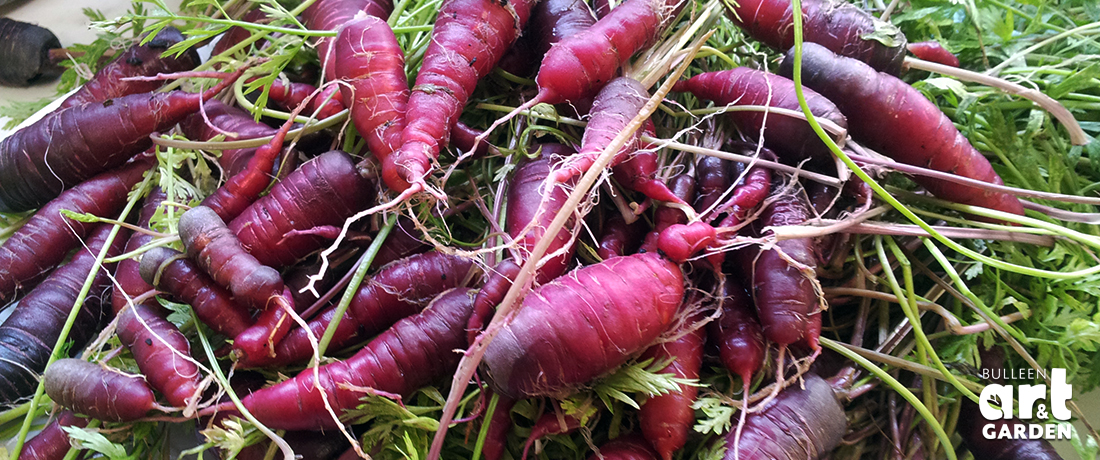
 Important note about plant availability. Important note about plant availability.There are hundreds of factsheets on our website provided for your information. Not all plants will be available at all times throughout the year. To confirm availability please call (03) 8850 3030 and ask for the nursery. |
Carrots are a favourite of bunnies and health nuts everywhere. Rich in antioxidants like Beta Carotene, Alpha Carotene, Phytochemicals and Glutathione, Calcium and Potassium, as well as vitamins A, B1, B2, C, and E, carrots are indeed a tasty little super-food.
Planting Time: Sept – May
Position: Full sun – part shade
Water Needs: Moderate
Difficulty: Moderate
How Long: 8 – 14 weeks
As carrots are a root vegetable, it’s going to be necessary to get your hands dirty. Rocks, stones and really heavy soil will slow down growth and deform your carrots. Manually pick through your bed before planting, remove obstacles and treat really heavy soils with a mixture of sand and compost.
Carrots need good drainage and gardeners commonly add sand to their clay or heavy loam soils to improve drainage. Carrots taste best when they are grown really quickly and good soil preparation is paramount here. Compost is good and, depending on the carrot varieties you going to grow, a nice deep topsoil layer is important. But if you want to grow a wee variety, like the round “ball” carrots or the baby carrots, topsoil depth is less important.

Carrots are best planted from seed rather than seedlings as they don’t transplant well. This is what is known as “direct sowing” and here’s how to do it. Firstly make a trench about 2cm deep and as long as you like. Sow your carrot seed by tapping them out of the packet along the row. Alternatively, prior to planting the seeds mix them into some sand in a small container and spread this mix along the row. This helps to thin the seeds out so they are nicely spaced and have room to grow. Fill this trench halfway up with a soil/sand mix or a shop bought seed raising mix – it’s pretty much the same thing. Press lightly on the covering mix to ensure contact with the soil and seed. Water it in gently so you don’t blast them out of the ground. Cover the bed with a light sprinkling of straw mulch. Keep the bed damp until your carrots pop their little heads through…. this should take about 2 – 3 weeks.
Once the seedlings are 5cm high it’s time thin them out. This means pulling out the weaker or smaller seedlings and leaving about 3cm between each of your carrots. You will need to do this again when they get to about 12 – 15cm high, at which time you need to leave about 5cm between them. While this may seem a bit wasteful and unsustainable, it isn’t really. Seedlings from the first thinning can be composted or feed to the chooks, and the carrots pulled at the second thinning can actually be eaten.
Carrots respond well to a feed, just as long as it is not high in nitrogen. High nitrogen fertilisers will make big, bushy carrot tops but do nothing for the all-important root zones! Give them a liquid feed of fertiliser tea every few weeks just to speed up the process, but don’t overdo it, especially in rich soil.
Over watering is a more serious issue than under watering when it comes to carrots. Seeds need to be kept damp when germinating, but that certainly doesn’t mean soaking, or bone dry. Inconsistent watering regimes, especially allowing the soil to dry right out and then flooding it with water, will cause carrots to crack or split.
Keep track of when you sowed your carrot seed because they can be harvested from about 8 weeks onwards. Harvest what you need, when you need it. This harvesting technique prolongs the crop and avoids a carrot glut all at once. However, you’ll want to get them all out of the ground before the sugars turn to starch, which happens at about 16 – 18 weeks.
Pest and disease problems are almost non-existent for carrots apart from the carrot fly. Carrot flies lay their eggs in the young seedlings and their larvae eat and tunnel their way through the growing root. They can be deterred by using plenty of compost as well as by using some good companion plants, like spring onions, to act as decoys.
Carrots, like coriander, can bolt, which means they have a tendency to run to seed before producing their roots, generally when unusually cool weather is experienced in early spring.
Pop these guys in a patch with good companions like: beans, coriander, chives, cucumber, lettuce, marjoram, rosemary and tomatoes. Avoid planting with celery and dill.
 Important note about plant availability. Important note about plant availability.There are hundreds of factsheets on our website provided for your information. Not all plants will be available at all times throughout the year. To confirm availability please call (03) 8850 3030 and ask for the nursery. |
Varieties to look out for include:
All-Seasons: A tasty, crunchy, quite large carrot which is very forgiving for the beginner gardener. Can be planted all year round in Melbourne.
Baby: Who doesn’t love a baby carrot? Sweet, small, quick and easy to grow, baby carrots are a good choice for smaller plots and pots.
Golf Ball or Mini Round: Cute, sweet round golf ball sized carrots, perfect for pots and very heavy soils. The kids will love them!
Purple Dragon: A stunner, the Purple Dragon carrot is fast growing and, at maturity, has a deep purple outer with an orange core. Impress your friends.
Topweight: The “traditional” carrot, Topweight is a favourite of home gardeners. Well-shaped, tapered and tasty, Topweight can be grown year-round.
